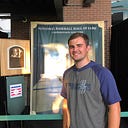Who has the Best Battery in Baseball?

Upon reading this title you may be thinking to yourself “Well I like Duracell better, but Energizer does have a cool bunny so I’m not really sure” and to your point that is a very valid debate but I’m not here to talk about a battery you might put in a remote or a toy, I’m here to talk about a baseball battery. A battery in baseball is a reference to the duo of the pitcher and catcher. These two are very important as they have a lot of control over a game. A strong connection between you pitcher and catcher is vital, as they work together to game plan how to manage hitters throughout the lineup. When the pitcher and catcher are on the same page this helps a pitcher perform tremendously. In the MLB sometimes we see pitchers with a “personal catcher”, or a catcher that the team will play during games that starting pitcher is throwing. Most notably we saw this impact the trade market. When Yu Darvish was traded to San Diego catcher Victor Caratini was also included in the deal. This is because in 2020, which was Darvish’s best season, he threw exclusively to Caratini, something the Padres want to continue in 2021 and beyond. This led me to begin the question who the best battery duo is in baseball. I decided to approach this question in a multitude of ways which I will lay out for you here.
The Combined WAR Method
Yes this method is exactly what is implied in the title we’re going to take a pitcher’s total contributions and add them to their catcher’s total contributions and see who comes out on top. While this is a good method there are definitely pros and cons to this approach. Some of the pros are that WAR accounts for everything a player does on the field and is park adjusted, so players won’t be penalized or awarded based on the ballpark they play in. It also is in the same units for pitchers and hitters even though the calculations may be different. Some of the cons to this method though are that WAR is a counting statistic meaning those who play more are going to have more chances to reach a higher WAR. This puts pitchers like Justin Verlander and Chris Sale who have missed most of the 2020 season at a disadvantage. To help lessen the effects of this bias the WAR totals will be combined from the 2019 and 2020 seasons. Here are the top ten using this method:
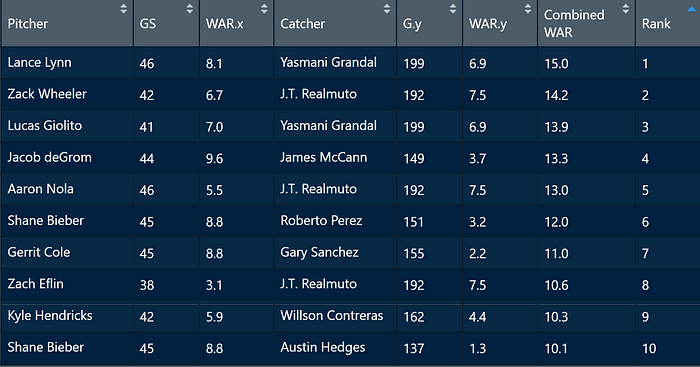

Based on these scatter plots we can begin to see some trends in the data. Clearly there are two catcher’s that are a cut above the rest in Yasmani Grandal and JT Realmuto, and it’s not even close. This also results in some pitchers being higher rank than maybe they should and we can see this on the graph with Zach Eflin and Dallas Keuchel. We can see that Eflin is ranked 8th when we use this method but that is mainly because Realmuto is so valuable. However we can see that the correlation is higher amongst pitcher’s WAR and rank than catcher’s WAR and rank. I think this is mainly due to the fact that pitcher WAR totals on average are higher than catcher WAR totals meaning it’s going to be more impactful when we add these two together. I think this method is a way to get on the right track, we can start to see clear tiers developing among the positions but there are still areas we can improve.
The WAR/G Method
This method is similar to the previous one except we are controlling based on the number of games pitched and played by the pitcher and catcher (not necessarily games played together). This is to help pitchers like Verlander, Sale who may come up short in overall WAR due to injuries. This also gives us an idea of in one game how much better of a chance does each of these batteries provide to win the game over replacement level. So here is the top ten using this method:
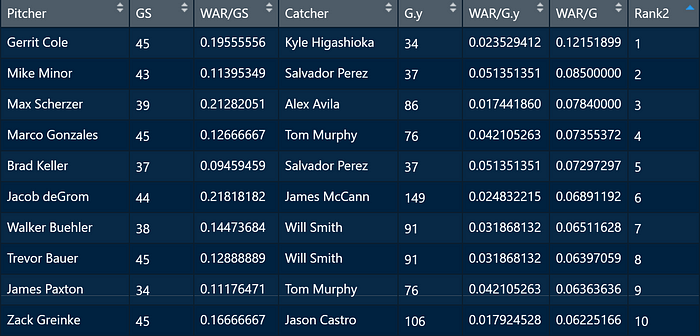

Now we start to see some interesting names on the list. Most notably duos that include Salvador Perez and Tom Murphy. Both of these catchers missed an entire season (Perez in 2019 and Murphy in 2020) so by taking WAR and creating a rate on a per game basis we can see what players performed better over a smaller sample. Though this is a small sample so we can’t 100% confidently say that they would had performed to this rate over a larger sample. With this method we also see the correlation between the two graphs to become much closer. Since catchers play everyday their rate is going to be lower than a starting pitcher who only starts about 30 games per season. The ranking is based off a formula:
(Pitcher WAR + Catcher WAR)/(Pitcher GS + Catcher G)
This in turn changed the correlation so now the catchers correlation is slightly higher because they are playing more games. Now the correlations are much closer meaning that when evaluating which duo is the best, both pitcher and catcher stats have similar importance. One thing though that is prevalent for both methods is that catchers have the ability to generate WAR in multiple ways with offense, defense, and base running. Pitchers however don’t have this luxury. The next method looks at a way we can approach this dilemma.
Defense WAR Only Method
When we think of the best battery in the game we think of the best pitcher/catcher duo. Some may interpret this as just the best overall duo between catcher and pitcher but some may interpret this as the best duo on the same side of the ball. What I mean by this is looking at best pitchers with the best defensive catchers. If a battery’s collective main goal is to prevent the other team from scoring we have to take the offensive and base running parts of WAR out. By doing this we can get a catcher’s defensive WAR, we can see that in the previous two graphs there are great defensive catcher’s whose WAR values are negatively impacted by their offense such as Mike Zunino, Austin Hedges, Martin Maldonado etc. This method will eliminate that negative effect on their defensive value. So in this method we will calculate combined WAR using a pitcher’s WAR and a catcher’s defensive WAR which can be seen below:
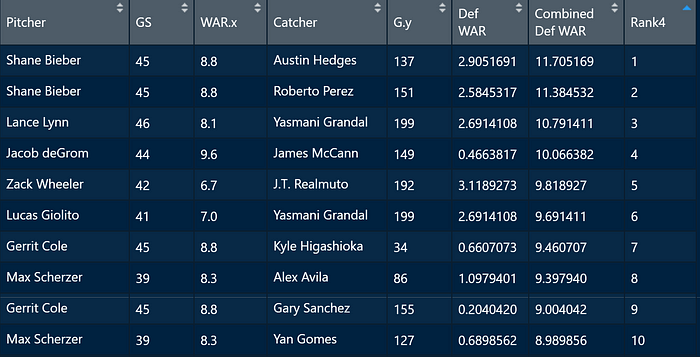

Biggest takeaway from this method is the emphasis it puts in the pitcher’s WAR. This isn’t all too surprising though because we essentially removed 2/3 of the way a catcher can generate WAR. By doing this we can see the player’s who received a significant boost. The tier of Hedges, Perez, Grandal,Vazquez, and Realmuto are clearly way above the rest, almost an entire win greater than the next best catchers. While this method does clearly benefit those catchers who are great defenders it also diminishes the overall value of the catcher in the duo, making the rank more dependent on how good the pitcher was. This method alone can’t tell us who the best battery is but we can take elements from each of these methods to get our answer.
Overall Leaders
Having gone through 3 different approaches each with an emphasis in a different aspect of the relationship with the catcher and pitcher we can use each of these to see who comes out on top. By taking the average ranking in each of the three different method we can see who consistently was ranking towards the top. Below are the top ten in average rankings:
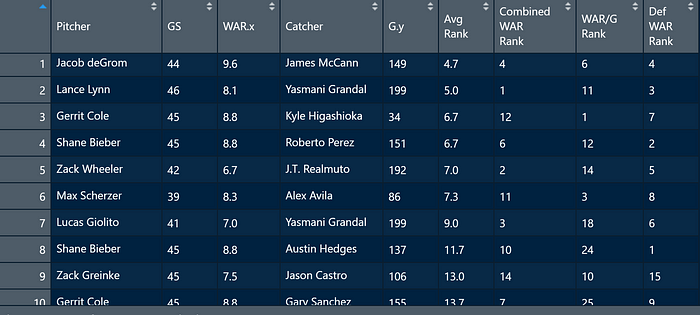
Now this list looks similar to the one I expected to see. Jacob deGrom is the top pitcher in the game so it’s no surprise to see him at the top especially paired with the newly acquired James McCann who has been very good with the White Sox over the past two seasons. Perhaps the biggest surprise of this list is Gerrit Cole and Kyle Higashioka. Clearly this is because of the number one rank in the WAR/G category. Higashioka has been very productive when he has been given a chance to play. Gerrit Cole also has way better numbers with him behind the plate due to him being a defensive upgrade over Gary Sanchez. This was another area I wanted to explore but because of limitations I didn’t include it in my rankings but will provide some insights I found.
Comparing Pitcher Stats Across Catchers
Like I mentioned earlier some pitchers have a personal catcher that they prefer throwing too and get better results from. Thanks to Baseball Reference’s splits we can actually see each pitcher’s stats split between each catcher they have thrown too. I wanted to include this in my analysis but since a lot of pitcher’s have new catcher’s or vice versa there just wasn’t enough data for every duo in my rankings. However I will go over what I found for those who did have data with their current catcher. Just a couple things to note when acquiring this data I used 2020 splits but with a few modifications. I used 2019 data for Strasburg,Sale,Eduardo Rodriguez,Verlander, and Miles Mikolas(injury),Greinke and Darvish(They only threw to one catcher in 2020), and Charlie Morton (d’Arnaud and him were teammates in 2019 but not 2020). To find out how much better or worse a pitcher was with a certain catcher I found the change in ERA,FIP,K/9,BB/9,and HR/9 and got an average percent increase or decrease amongst these 5 statistics. I did include ERA because it is still important but I also wanted to eliminate as much luck as possible, so I chose statistics that a pitcher and catcher can control and take the defense behind them out of it. I should also explain how to read these differences. Since K/9 is good and we want a higher value there but lower value in all the others I had to make it read the same. So a positive value in ERA, BB/9,HR/9 and FIP means it was that lower than the other catchers, where as a negative value means that is was higher than the others. With K/9 a positive value means it was that much higher and a negative value means it was that much lower. The Avg Change % is read as a % so 1.4 = 140%. Here are the rankings:
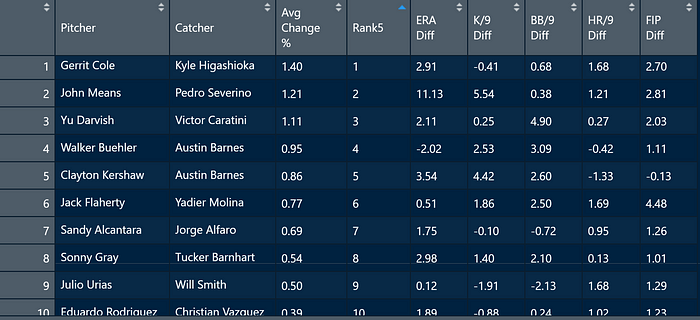
Once again we see the duo of Gerrit Cole and Kyle Higashioka. Even though it has been a small sample so far Gerrit Cole has been so much better with him behind the plate. I understand why Gary Sanchez still garners a lot of playing time because of the bat. When you invest the amount of money that you did in Gerrit Cole though why not maximize that asset and give him the best chance to be his best. This is a duo that I am interested in seeing in 2021 and how the Yankees handle the platoon with Sanchez and Higashioka.
With that we have researched who the best battery in baseball is. I am not surprised to see deGrom at the top with the best pitchers and catchers in the game filling out the top ten. Let me know who you think deserves to be in the top spot and who you think may be an underrated duo. Below I’ll include all the data if you would like to explore the full lists and thank you so much for supporting me and reading this article!
